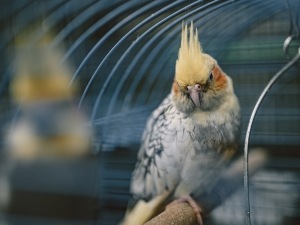
There are a variety of different ways to feed your bird one of which is hand feeding the bird, and as with everything, there are pros and cons to doing this
This article explores the problems that can develop when hand-feeding your cockatiels.
Table of Contents
Hand-feeding cockatiel problems:
Hand-fed cockatiels are usually the most affectionate and sweetest bird that you may come into contact with, this is because the bird will imprint on the feeder when being hand fed.
However, hand feeding does come with some risks including:
Crop not emptying:
If you’re hand-feeding your birds one of the issues that you may run into will be that the bird’s crop does not fully empty by the time you’re wanting to feed the birds again.
One of the reasons why this may be happening is that the crop becomes overstretched while the bird is feeding and doesn’t go back to its original shape, and food gets stuck in the crop.
Dehydration or a systemic disease can also be the cause of this condition in your bird.
How to avoid this:
You can treat the bird if the bird’s crop is not emptying because the bird is dehydrated, and rehydrate the bird by giving the bird electrolytes.
If the bird’s crop is not emptying because the bird has a systemic disease then taking your bird to the vet and having them diagnose and treat the bird is the way to go.
If the bird’s crop is not emptying because the crop is stretched out then the bird can be given a crop bra to wear.
The crop bra will both support the crop and keep it from stretching out even more and will protect the bird’s chest from being pecked by other birds.
Making sure that the crop empties is a must, if you don’t keep this from happening in your bird then the bird may start to suffer from crop stasis.
Crop stasis is when the crop doesn’t allow any food to move past it and this can lead to crop impaction or even sour crop.
Aspiration:
Aspiration is not only dangerous for your pet birds, but it can also be fatal to the bird as well.
If your bird doesn’t want to feed, but food lands in its mouth, then the bird may accidentally inhale the feed as it is inhaling and this can lead it to aspirate the food into its lungs.
The bird may cough or sneeze the formula out but if the bird can’t do this then it will start gasping for air, shake its head, and may even die of asphyxiation.
This also happens if the bird is being fed formula that is too thin, if the bird is eating too slowly, or, if the bird is being overfed.
How to avoid this:
Feeding birds when they give you feeding cues is one way of keeping this from happening. The bird will rapidly bob it’s head and neck when it is ready to be fed.
Excessive begging:
This is another problem that can come with hand-feeding your birds. Because the birds are fed by you and can’t feed themselves the birds may beg excessively for food.
This may happen because the bird is not being fed as frequently as it would need to be fed or because the syringe doesn’t hold enough food for the bird.
If the bird is not having enough food then the bird can start to become malnourished and this can negatively affect the bird’s growth.
How to avoid this:
Making sure that you feed the bird frequently and making sure that the birds are fed enough food every time they eat will keep the bird from begging for more food.
It is recommended that you weigh each bird in the morning before they start to feed in order to calculate exactly how much food to feed the bird daily.
This will also o help you keep track of the progression of the bird’s growth.
Slow digestion:
Slow digestion of your bird’s food can result in a yeast infection developing in your bird’s crop as food isn’t moving down the crop as quickly as it should.
This can develop in your bird if you give the bird formula that is too cold for the bird.
Cold formula is usually rejected by birds but if it is eaten then the bird can develop a yeast infection or sour crop
How to avoid this:
Making sure that the temperature of your bird’s food is correct will help to keep this from happening.
The hand-feeding formula that you buy for your birds will usually have specific directions on how they should be prepared, follow these to a tee.
If you enjoyed this article then you may also be interested in other bird related articles. Here are some articles that you may be interested in: Cockatiel Signs Of Stress, Cockatiel Temperament, Baby Bird Heat Lamp, Why Does My Budgie Put His Foot On The Other Budgie?, Why Are My Conures Feathers Turning White?, Natural Anti-Inflammatory For Birds, Birds’ Feathers Curling Up

